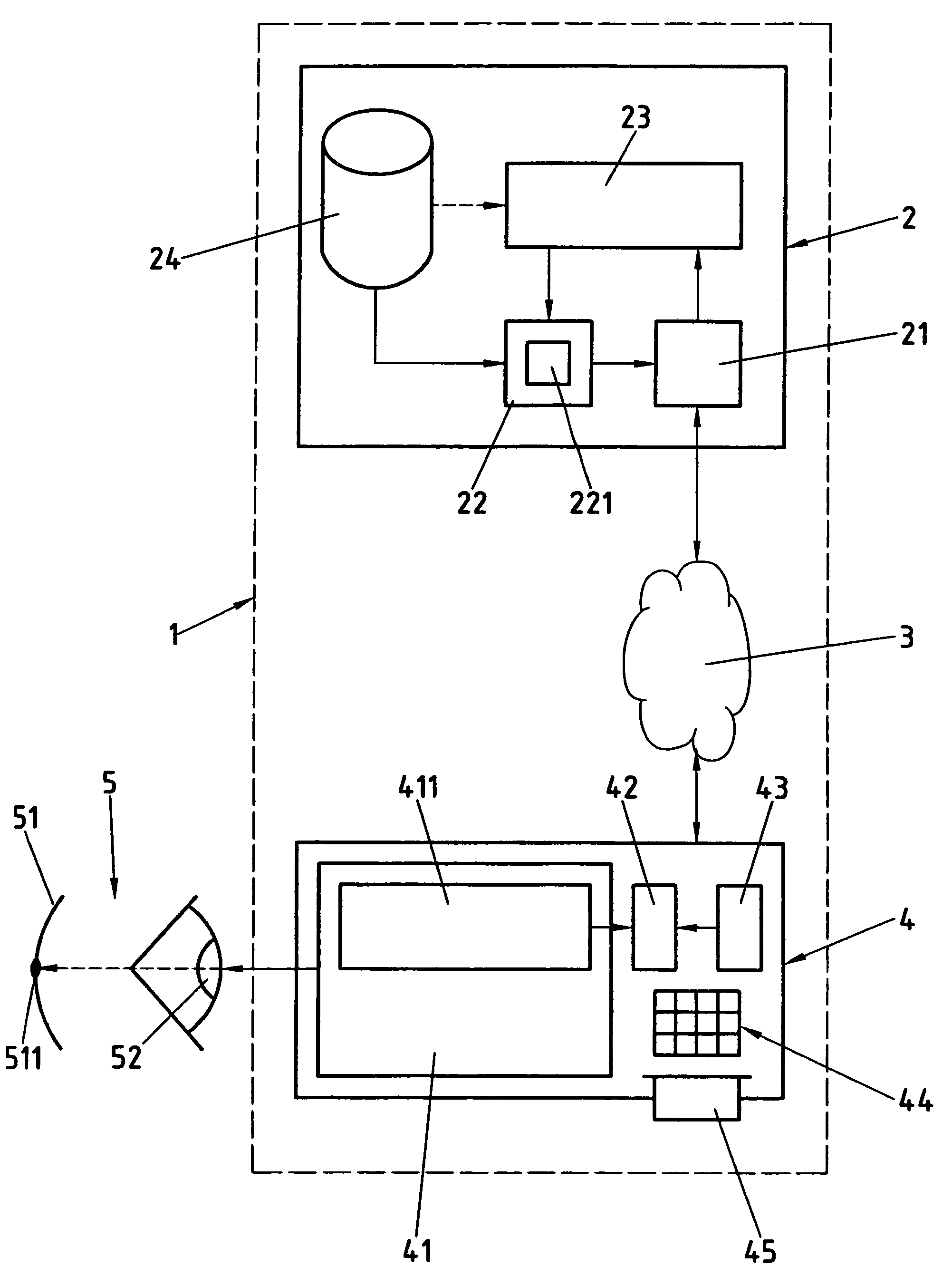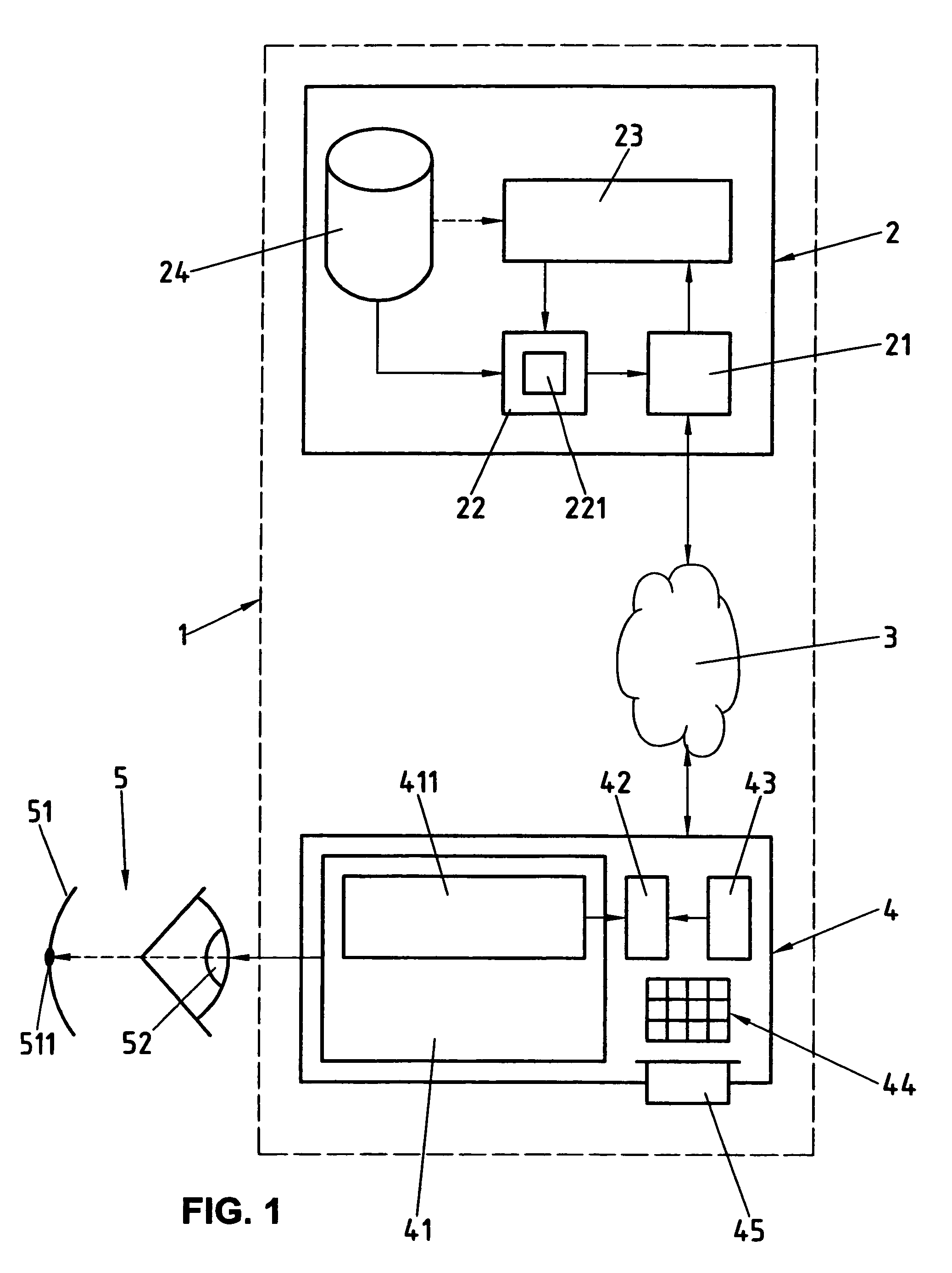[0006]It is an object of this invention to propose a new and better system, a new and better method and suitable devices for transmitting and presenting video data which in particular make possible shorter transmission times during transmission over a
telecommunications network.
[0008]In the system for transmitting and presenting video data which includes a video center with a communications module as well as a
telecommunications network with at least one communications terminal connected thereto, the video center being able to transmit by means of the communications module video data via the
telecommunications network to a communications terminal, this communications terminal comprising at least one video
display device that presents received video data to the user of the communications terminal in a visible way, and which includes an
eye position tracking module that determines current eye positions of the user, and the communications terminal including an
eye position feedback module that transmits the determined current eye positions to the video center, this object is achieved through the invention in particular by the video center including a
database and / or a
file server with
digital video data, by the video
display device being a virtual
retinal display device (Virtual
Retinal Display, VRD), which projects picture signals corresponding to the received video data onto the retina of the said user, and by the video center including a video filter module, which filters the video data, prior to their transmission, on the basis of received current eye positions such that outer picture regions, corresponding to the video data, which are projected onto the retina outside the fovea, have a lower resolution than inner picture regions, corresponding to the video data, which are projected on the fovea of the retina. Moreover the filtered video data therefore contain a lesser data quantity than the unfiltered video data. The
advantage of this system and of the corresponding method consists in that a particular characteristic of the
human eye, i.e. the fact that a small region of the retina having an optic angle of approximately 2°, the so-called fovea, has the sharpest vision, can be exploited in such a way that the quantity of data to be transmitted can be drastically reduced.
[0009]In an embodiment variant, the
telecommunications network includes a mobile network, for instance a
mobile radio network for
mobile telephony, e.g. a
GSM or UMTS network, and the communications terminals are
mobile radio devices, for instance a mobile radio telephone or a communication-capable
laptop or palmtop computer. This has the
advantage that mobile users can obtain video data from the video center and view video data by means of the video display device of their mobile devices, the video center not having to be directly connected to the mobile network, but being able to be reached over the mobile network via suitable network units, such as, for example, a Mobile Switching Center (MSC) or a
Short Message Service Center (SMSC).
[0010]In an embodiment variant, the video filter module has a
cut-out function which filters out at least certain of the said video data corresponding to the above-mentioned outer picture regions so that the picture region corresponding to the filtered video data is a section from the picture region corresponding to the unfiltered video data, which section contains at least the inner picture region. This has the
advantage that, in particular with a large total picture area, only those video data that are viewed by the user in detail have to be transmitted with a
high resolution.
[0011]In an embodiment variant, the video center includes a prediction module which stores eye positions determined by the
eye position tracking module, and which predicts a subsequent eye position on the basis of these stored eye positions. This has the advantage that the number of reports of eye positions to the video center, in particular with continuous change of the eye positions of the user, can be reduced, it being possible to increase it in the case of extreme change in eye positions, for example. In a further variant, the content of the video data can additionally be taken into consideration in the prediction of a subsequent eye position, so that the change in the eye position correlates with the movement of large and / or central objects, for instance.
[0012]In an embodiment variant, a correction module receives correction values from the user, stores received correction values, and corrects eye positions, determined by the eye
position tracking module, with stored correction values. This has the advantage that the agreement of determined eye positions with the position of the fovea of the user can be adjusted by the user by entering the correction values such that the picture region with the highest resolution is actually projected on the fovea.
 Login to View More
Login to View More  Login to View More
Login to View More 

